 |
 |
|
In the 1945 Leonard Bernstein musical "On The Town", three sailors ponder what to do in New York City with only 24 hours of shore leave. I didn't have quite that dilemma, but I did only have 30 minutes of layover at King Street Station in Seattle on Cascades train 517 heading back to Portland after a weekend trip. So, as any good railfan does, I got out my camera and went big train hunting... |
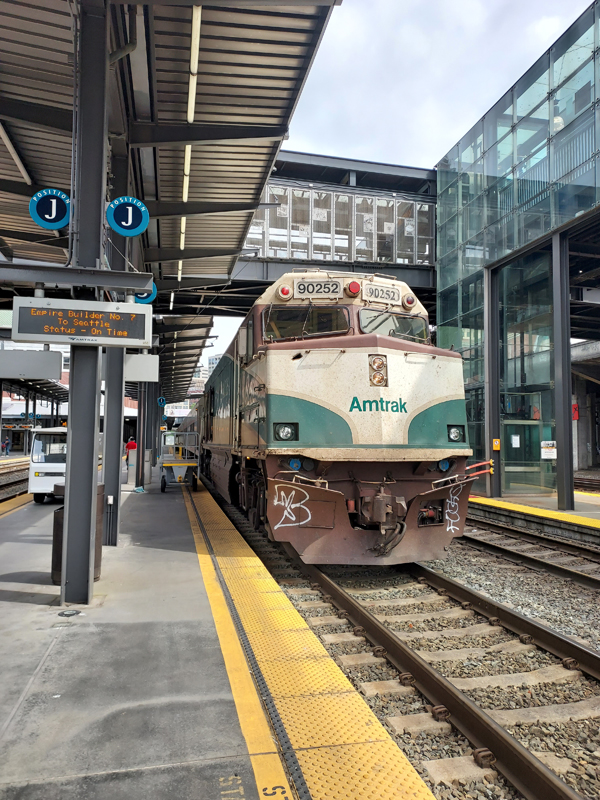 |
|
There's Amtrak NPCU 90252, built originally as F40PH 252, leading Cascades 517. When Amtrak added a fleet of TALGO trainsets for its Cascades service in 1998, it sent five of these out to the Pacific Northwest in a distinctive brown, cream and green color scheme as cab cars for the consists. All five - 90250-90253 and 90340 - remain in Cascades service today, although the 90250 has been repainted into Amtrak's standard Phase V color scheme. The Cascades NPCUs were originally converted without the roll-up baggage doors found on Amtrak's other F40PH conversions, since each of the service's five TALGO VI trainsets had a dedicated baggage car. Those sets, minus one that had been wrecked in a derailment at Dupont, Wash. in December 2017, were retired in 2020, being replaced by older Horizon series coaches and cafe cars. The NPCUs received their roll-up baggage doors so that they could serve as the baggage cars for the Horizon-equipped consists. |
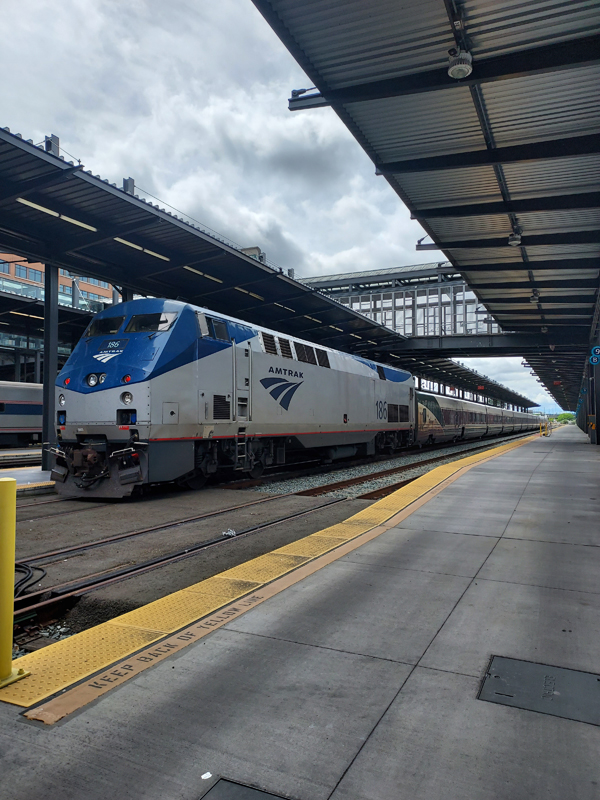 |
Amtrak 186 is a GE P42-9 locomotive dating from the late 1990s. It wears the Phase V color scheme and stands out in stark contrast to its train. The 186 is laying over with one of two TALGO trainsets still in Cascades service. The TALGO VIII sets, named "Mt. Jefferson" and "Mt. Bachelor", are owned by the state of Oregon and entered service in 2013.
|
|
They were part of a four-set order built by TALGO at its Milwaukee, Wisc. plant. Two of the sets were ordered for Wisconsin DOT and would have entered Hiawatha Service between Chicago and Milwaukee with a future extension to Madison. Due to a change in political administrations, the Wisconsin sets, plus three spare cars, never entered service and were subsequently stored at Amtrak's Beech Grove, Ind. shops until 2019, when they returned to the TALGO plant in Milwaukee for possible use in Cascades service after the retirement of the TALGO VI sets. Addition of the two TALGO VIII sets from the Wisconsin order, plus the spares (one each cab car, end car and cafe) with the existing Oregon DOT TALGO sets would have given the service enough rolling stock to have five 11-car sets, plus two spare cars. Washington DOT declined to accept TALGO's offer for them, however, and they remained at Milwaukee until their sale for a transit operation in Lagos, Nigeria. |
|
The other end of the TALGO VIII set is this distinctive cab car that is also the auxiliary power car for the train. The south end of the King Street Station platforms lies in the shadow of Seattle's Lumen Field, the home stadium for the NFL Seahawks, MLS Sounders and NWSL Reign. In the far background is the retractable roof for the city's other stadium in the SODO district, T-Mobile Park, the home of Major League Baseball's Mariners. The stadium's roof rolls on a track and is stored over top of the BNSF main tracks and the leads to the Amtrak/Sounder coach yard south of the station. |
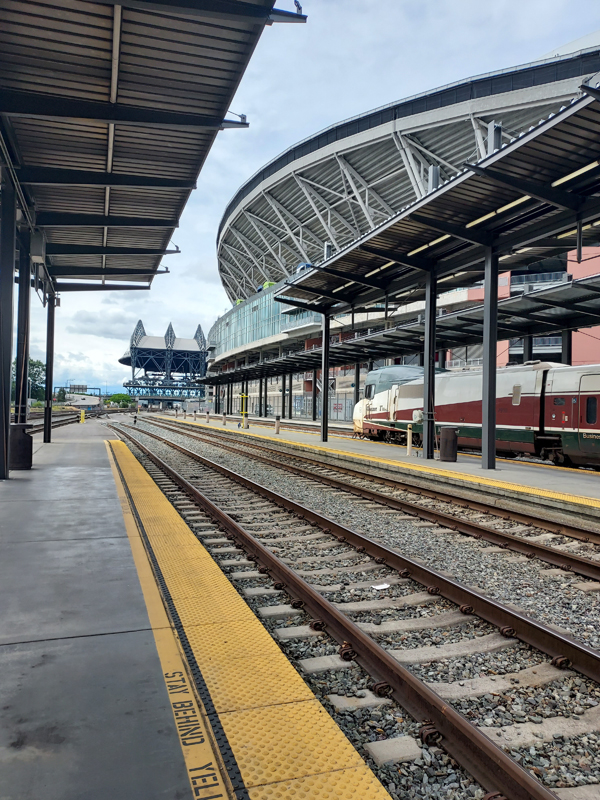 |
|
The stadia replaced the iconic Seattle Kingdome, which occupied the footprint of what is now Lumen Field. The old stadium served the city from 1976 until 2000, when it was destroyed in a spectacular implosion. Their location next to King Street Station provides for easy access by sports fans or event attendees arriving by Amtrak or Sounder trains. For many years, both agencies operated extra trains on game days in addition to regular schedules. The city's other stadium, Climate Pledge Arena (formerly Key Arena), is the home of the NHL Kraken and the WNBA Storm. It is located at Seattle Center, home of the 1962 World's Fair and its iconic Space Needle. It is transit-accessible from King Street Station by taking Sound Transit's Link light rail from the adjacent International District station to Westlake Center, where it connects with the famed Seattle Center monorail, also remaining from the 1962 fair. |
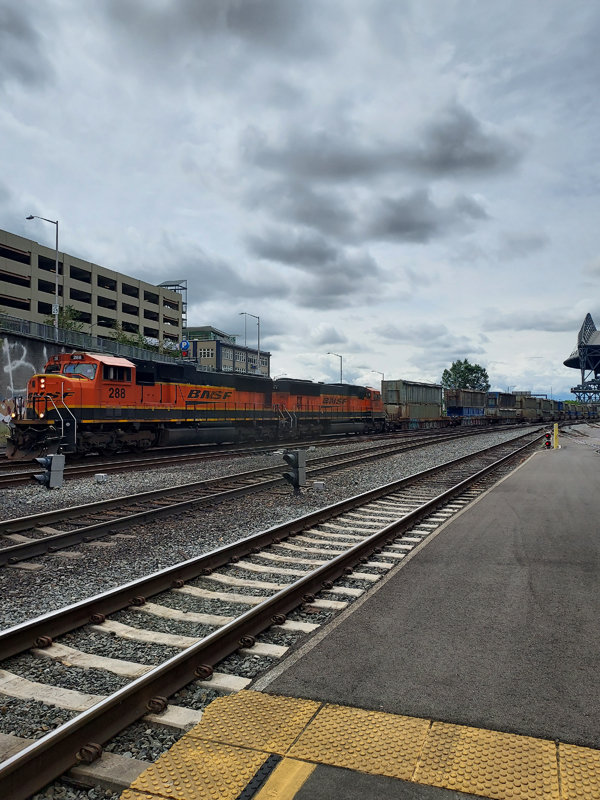 |
The BNSF main line runs along the east side of the King Street Station complex. This is the dividing line between the Scenic Sub running north and east and the Seattle Sub running south. Here's a northbound BNSF train, hauling empty trash containers back from a transfer station in Roosevelt, Wash. The train is led by a pair of BNSF-painted SD75s. Lead unit 288 is a former Santa Fe SD75I, while trailing unit 268 is a former Santa Fe SD75M. |
|
Both BNSF and Union Pacific operate unit trash trains between the Puget Sound region and the upper Columbia River basin. The BNSF trains run to and from a transfer facility at Roosevelt, Wash., where containers are loaded onto flatbed trailers for the final lap to the landfill north of the river. There are also intermediate transfer stations at Black River Junction and at Centralia. Loaded trains originate at Everett, north of Seattle, and at Interbay Yard, north of downtown Seattle. The Union Pacific's trains run to and from a transfer facility south of Arlington, Ore., on the south side of the Columbia River. The trains operate with locomotives on each end because they must reverse direction at Arlington to enter the branch line on which the transfer facility is located. The UP's loaded trains originate at Seattle and on the Puget Sound & Pacific shortline northwest of Centralia. |
King Street is also the terminus for two of Amtrak's overnight long-distance trains, the Seattle-Chicago Empire Builder and the Seattle-L.A. Coast Starlight. This is the Seattle section of the Empire Builder arriving after a two-day trek across the northern plains and through the Rockies and Cascades. |
 |
|
The Empire Builder operates to and from both Seattle and Portland, with the sections joining or separating at Spokane in northeastern Washington. Both long-distance services to and from Seattle have recently introduced Amtrak's newest motive power, the Siemens-built ALC-42. This model follows the Siemens SC-44, which operates in regional Amtrak service in the Midwest and in California, and also in Cascades service. |
 |
The arriving Empire Builder also brought in an extra Horizon coach for Cascades service. It will allow Amtrak and WSDOT to add or expand consists for additional Cascades trains. In past years, Amtrak has also deadheaded Amfleet and Horizon cars into Seattle for extra trains such as Portland-Seattle football specials and holiday runs such as the Christmas season Snow Train to Leavenworth, WA. |
|
Currently, Amtrak and WSDOT have five-car sets (4 coaches and a cafe) of Horizon Fleet equipment and two TALGO VIII sets to cover Cascades service, including a Seattle-Vancouver, BC round trip; a Portland-Vancouver, BC round trip; two Seattle-Eugene, Ore. round trips; and three Seattle-Portland round trips. They added two of the Portland-Seattle round trips in the fall of 2023; these are trips that would have been added with the 2017 opening of the Point Defiance Bypass in the Tacoma area, which was suspended after the December 2017 wreck of Cascades 501, the inaugural train on the new route, at Dupont. Amtrak and WSDOT are expected to introduce eight new Airo trainsets, built by Siemens, into Cascades service beginning in 2025. These six-car sets will include coach, cafe and business-class cars, including a cab-coach. They are part of a planned 83 Airo sets to replace Amtrak's 1970s-vintage Amfleet I car fleet and 1960s-vintage Metroliner cars converted to cab-coaches on Northeast Regional trains, on state-supported trains such as the Keystone Service in Pennsylvania and Piedmont Service in North Carolina, and on medium-distance trains such as the NYC-Savannah Palmetto and NYC-Charlotte Carolinian. |
Amtrak 325 is one of 75 ALC-42s in Amtrak's original order. The new units debuted in regular service on the Empire Builder in February 2022. Amtrak subsequently increased the order to 125 units. They will allow the retirement of older GE P40, P42 and P32-8BWHs. ALC-42s 300 and 302-306 wear the Phase VI color scheme, while 301 has a special "Day One" scheme to honor Amtrak's 50th Anniversary. The scheme also appeared on ex-Penn Central E8 4316, painted for the first day of Amtrak service on May 1, 1971. Units 307 and up have a new Phase VII scheme. |
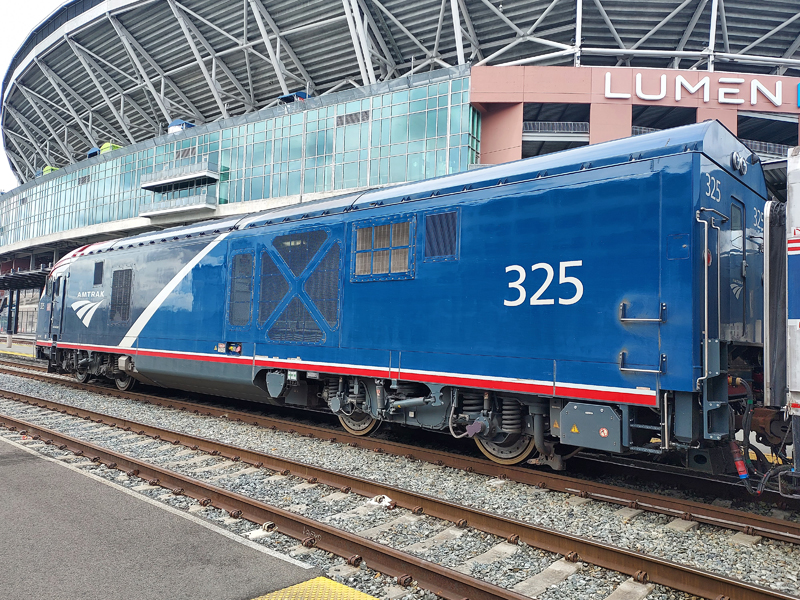 |
|
Amtrak has also ordered a fleet of ALC-42E units to accompany its planned Airo trainsets from Siemens. These modified units will operate on Airo-equipped services that also use the Northeast Corridor. They will be able to operate on diesel power away from the NEC catenary, or draw A.C. power from an adjacent coach/APU that will have powered trucks, A.C. transmission equipment, and a pantograph on the end closest to the locomotive. The other end of the car would be the business-class coach. Other modified ALC-42Es would operate on Amtrak Empire Service trains, the Adirondack, the Ethan Allen and the Maple Leaf that operate north from NYC Penn Station. These trains, which currently operate with dual-mode diesel/third-rail P32AC-DMs, would have a battery coach/APU instead of an A.C. coach/APU. The ALC-42Es and their Airo trainsets will have the new Phase VII color scheme, except for the eight sets planned for Cascades service. These will have a new scheme incorporating the current brown, cream and green Cascades colors. |
| To navigate through the site, just click on one of the links in our image map. | |
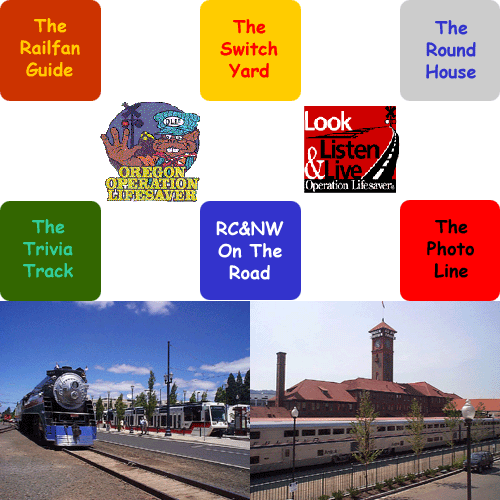 |